
Welcome to Michigan Lakes!
We are all about Michigan lakes. Life on, in and near Michigan's lakefront brings a richness that rewards for a lifetime. Have a story or comments on your experience? You can be one of the first to share it with the world on our Michigan lake directory.
- Error
Cabins, Cottages & Homes
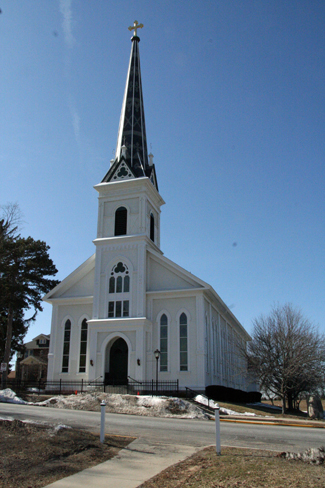 In preparation for tomorrow’s St. Patrick’s Day, I thought I would post a view of St. Patrick’s Church in Parnell Township, Kent County.
In preparation for tomorrow’s St. Patrick’s Day, I thought I would post a view of St. Patrick’s Church in Parnell Township, Kent County.
Scattered throughout the Michigan countryside there are many older country churches, but not many with the beauty and character of St. Patrick’s. Founded in 1844, the church is located on the corner of Parnell and Five Mile Road.
When approaching the village of Parnell, one can’t help but notice the 160? tall and stately steeple on this historic church.
The beauty of the stained glass windows and the abundance of wood is unmatched by the churches built today.
Outside on a large rock a brass plaque reads “With respect for the past, Commitment to the present and a belief in the future of our Christian faith”
Read about the History of St Patricks.
Labor Day
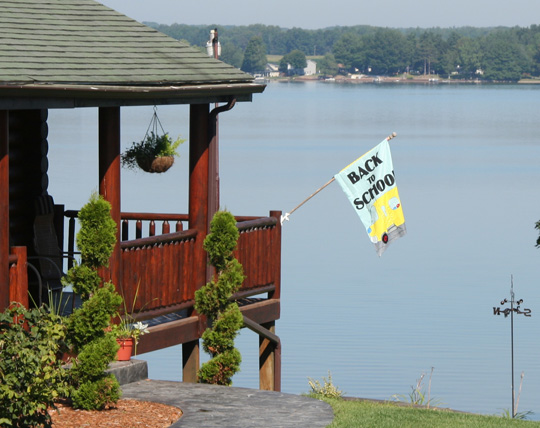 Labor Day is always the first Monday in September. It is a day set aside to honor of the American worker and to celebrate the contributions they have made to the strength, prosperity, and well-being of the United States.
Labor Day is always the first Monday in September. It is a day set aside to honor of the American worker and to celebrate the contributions they have made to the strength, prosperity, and well-being of the United States.
In Michigan, Labor Day is a symbolic signal that summer is drawing to a close. A time when Lakefront property owners start thinking of closing up their cottage and moving back home.
Labor Day is a signal that school is starting again, along with many activities starting up again. So be it, but we have a lot of good weather ahead yet.
The End of the Road
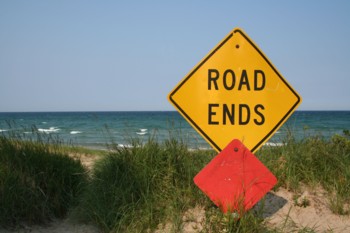 Life is an wonderful gift from God. It is full of opportunities and challenges. It has its shares of ups and downs, twist and turns. Sometimes we are surprised by the events of our lives.
Life is an wonderful gift from God. It is full of opportunities and challenges. It has its shares of ups and downs, twist and turns. Sometimes we are surprised by the events of our lives.
At times, much like driving down the West Michigan roads, there are signs informing us of what is on the road ahead of us, merging lanes, oncoming traffic, construction ahead, warnings to expect slowdowns and a host of other signs.
I was traveling on an unfamiliar road the other day when I came up to a “Road Ends” sign. When you are on your way to a particular destination, the last sign you want to see is a “Road Ends” sign. Coming upon that sign means you have taken a wrong turn, or you are just plain lost.
That sign got me to thinking about life. In life can you can also come upon a “Road Ends” sign. If you let it, it can be a bleak time filled with disappointment, confusion and discouragement. But, always keep in mind that sometimes we need to come to the end of our road before we can enjoy the opportunities that are not a part of the road we were on.
To enjoy the lake, you must get off the road.
Night Lights
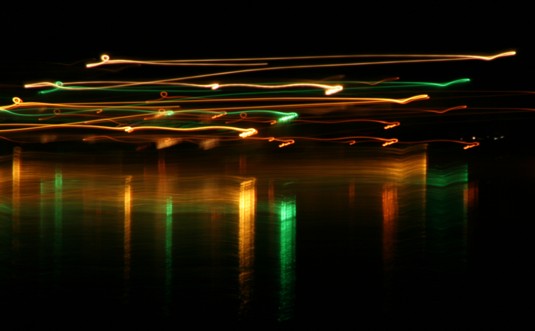 One of the interesting things about living on water is the variety of lights reflected on the water when darkness falls. Recently, I noticed several colored lights reflecting on the water. I had not seen these lights before and I am still not quite sure what they were, but I ran to get the camera. I set it up on my deck and took a few shots. After taking a few typical night shots, for a little variety, I set the shutter at a slow speed and moved the camera from side to side and this picture was the result.
One of the interesting things about living on water is the variety of lights reflected on the water when darkness falls. Recently, I noticed several colored lights reflecting on the water. I had not seen these lights before and I am still not quite sure what they were, but I ran to get the camera. I set it up on my deck and took a few shots. After taking a few typical night shots, for a little variety, I set the shutter at a slow speed and moved the camera from side to side and this picture was the result.Crowded Beach
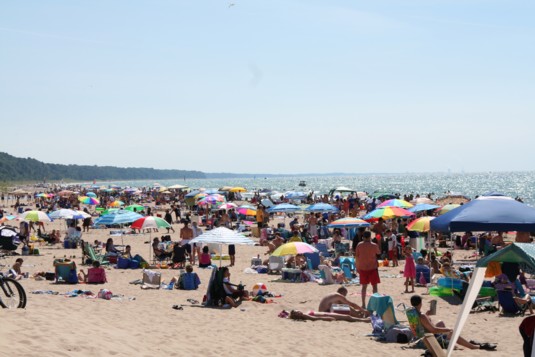
As they say, a picture is worth a thousand words. So, rather than writing a long list of reasons someone should buy lakefront property.
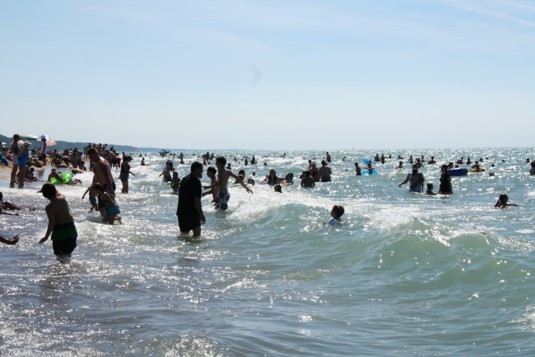
Sunrise
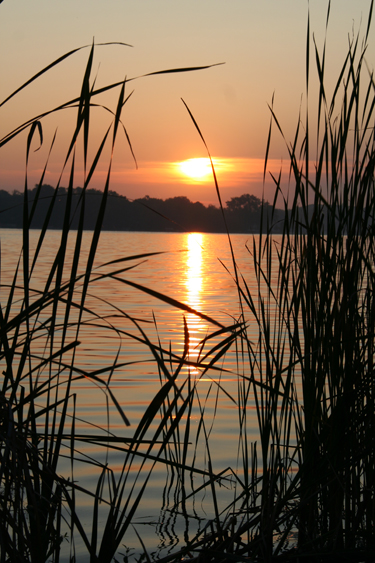 One thing I have always enjoyed is going out and taking pictures of the sunset over water. I have gone to several different lakes and set up my tripod, and waited for the spectacular sight of the sun slowly slipping down into the water.
One thing I have always enjoyed is going out and taking pictures of the sunset over water. I have gone to several different lakes and set up my tripod, and waited for the spectacular sight of the sun slowly slipping down into the water.
But, I may have a new passion, as a few days ago I happened to see this beautiful sunrise over the lake. I now have a new appreciation for the sight of the sun slowly rising out of the water to bring light and warmth to a brand new day.
Sunrises and Michigan Lakes share one thing in common: No two of them are alike.
Nature’s palette of colors ranges from pinks to reds to golds to blues. The water mirrors the story told in the sky.
When living on the lakefront, every day is a constantly changing panorama of nature’s beauty and surprises.
Go and check out more Skywatch images at the Skywatch Site!
Put Your Junk Back in Your Trunk
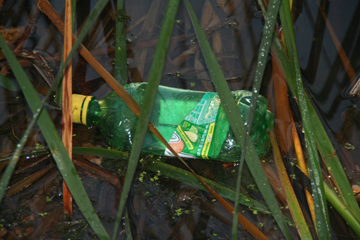 It is amazing how many times while traveling through Michigan I see a beautiful spot along the roadside, and since I am always looking for a photo op, I get excited and pull over. I get out and set up my gear, only to discover someone found this spot before me and left their trash.
It is amazing how many times while traveling through Michigan I see a beautiful spot along the roadside, and since I am always looking for a photo op, I get excited and pull over. I get out and set up my gear, only to discover someone found this spot before me and left their trash.
Someone carelessly tossed out their beer bottles/cans, fast food wrappers, etc., just because it was more convenient for them to toss it out than to take it with them and dispose of it properly.
What an inconsiderate action! One person’s laziness ruins Michigan’s pristine beauty for all who visit the site after them.
Today, I am posting a trashy photo with my request: Keep your junk in your own trunk!
Election Day
 It seems as if the campaign has been going on forever, but Election Day is here at last. Did you vote? If not, are you planning on voting? It is the right and responsibility of every citizen to vote, to do something, rather than do nothing and complain about our country and it’s leaders. Voting is a privilege that we as American’s must never take for granted.
It seems as if the campaign has been going on forever, but Election Day is here at last. Did you vote? If not, are you planning on voting? It is the right and responsibility of every citizen to vote, to do something, rather than do nothing and complain about our country and it’s leaders. Voting is a privilege that we as American’s must never take for granted.
The polls open before sunrise and I suspect many will be in line even before the polls open to exercise this right to vote. Many say the results will be close. It may be a late night of result watching. We may even have to wait until morning to hear if our candidate won.
Tomorrow morning I will be grateful that all the political ads will be gone, as well as the phone calls about this or that issue. Mostly I will be content when all the political signs, banners and bumpers stickers are gone.
But for today I will enjoy another Michigan sunrise and be thankful for the country I call home.
Ice Breaker
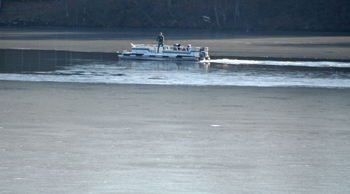 Okay, I know this is not an award winning photo. I hesitate to even post it. It was one of those moments that I wished I was a little quicker, had my camera closer and had a better lens and tripod at my side. But, enough of my excuses.
Okay, I know this is not an award winning photo. I hesitate to even post it. It was one of those moments that I wished I was a little quicker, had my camera closer and had a better lens and tripod at my side. But, enough of my excuses.
It is a shot of a lakefront owner who procrastinated getting his boat out of the water prior to the ice forming on the lake. Watching him breaking a path in front of his pontoon with his iron rod till he could reach clear water was humorous to watch, to say the least.
But, before I extol the virtues of timeliness in getting the boat stored for the winter, I must admit that a few years ago I found myself enlisting the help of my wife to do the same thing.
Since this gentleman is a neighbor of mine, I am grateful the shot is not that clear! I hope he does not find out he is the subject of today’s post.
As for the better lens, Christmas is coming and I hope my wife reads this post!
More on Riparian Rights
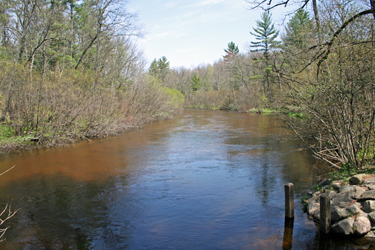 Recently I wrote a post about Michigan Riparian Rights . Since then, a question was posed to me. “ I have a riverfront cabin up north, sometimes after a hard rain or flooding, my shoreline moves. I find I have gained some land. Who owns that land?’
Recently I wrote a post about Michigan Riparian Rights . Since then, a question was posed to me. “ I have a riverfront cabin up north, sometimes after a hard rain or flooding, my shoreline moves. I find I have gained some land. Who owns that land?’
Let me introduce a term: Accretion. Accretion is a gradual process of nature where soil is deposited along one’s shoreline, adding to one’s overall waterfront. The opposite of this process in called erosion- the removing of one’s shoreline.
Who owns it? Generally speaking, the addition of land belongs to the owner of the adjacent riparian rights. Read the Law.
First Day of Winter
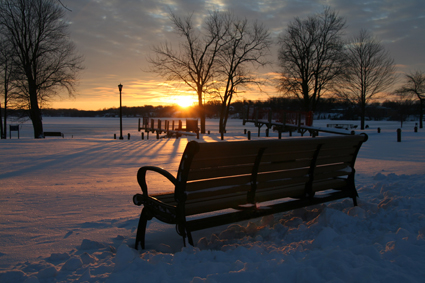 As I sit at my desk writing this entry, I am looking out of the window watching the snow fly. Right now I can see about half way across the lake, but for most of the morning I was only able to see my own backyard. The deck is barely recognizable because of the snow from previous storms.
As I sit at my desk writing this entry, I am looking out of the window watching the snow fly. Right now I can see about half way across the lake, but for most of the morning I was only able to see my own backyard. The deck is barely recognizable because of the snow from previous storms.
And, I look at the calendar and see today is the first day of winter! Enough said!
But, the good news is, that means the days will be getting longer and spring is getting closer; only some ninety days away.
Here’s to better weather in January!
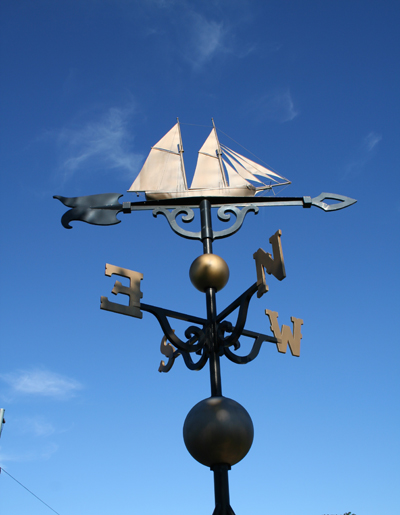 Whitehall may be home to the world’s largest weather vane. While no one knows for sure, Whitehall claims the title. The weather vane is 48 feet tall, 14 feet wide and weighs more than 2 tons. Topping the weather vane is a schooner, memorializing the Ella Ellenwood, a schooner destroyed in a storm on Lake Michigan in 1901. It stands in Ellenwood Park, also named after the schooner, at the corner of Dowling and Water Street.
Whitehall may be home to the world’s largest weather vane. While no one knows for sure, Whitehall claims the title. The weather vane is 48 feet tall, 14 feet wide and weighs more than 2 tons. Topping the weather vane is a schooner, memorializing the Ella Ellenwood, a schooner destroyed in a storm on Lake Michigan in 1901. It stands in Ellenwood Park, also named after the schooner, at the corner of Dowling and Water Street.
A plaque is located in the park with the details of the Ella Ellenwood:
The Saga of the Schooner “Ellenwood”
The 157 ton lumber schooner Ella Ellenwood was built in East Saginaw, Michigan in 1869. She was purchased by a Captain Thomas Flagstad of Montague, a native of Norway, who operated the schooner out of White Lake.
One the night of October 1, 1901, while bound for Milwaukee, Wisconsin with a load of maple edgings and shingles, the Ellenwood ran aground off Fox Point, about 8 miles north of the Milwaukee harbor. Within hours, strong northerly winds began to break up the schooner causing the captain and crew to abandon ship.
They made shore safely in the schooner’s yawl with the aid of a compass and an anchor light.
By the next day, the Ellenwood’s stern and transom were broken away and the hull so badly worked loose that the masts wobbled in opposite directions with each swell.
Only the bark cargo was salvaged. The maple edgings in the hold and the schooner were left to the elements.
The following spring, 1902, a portion of the wooden nameplate “ELLENWOOD” was found inside the White Lake Channel. Incredibly, the nameplate drifted around Lake Michigan and by mere chance, or fate, entered the narrow channel to White Lake and washed ashore in White Lake. The Ella Ellenwood had found her way home!
This 115 year old nameplate had a scale model of the Ellenwood is exhibited in the lobby of the Montague City Hall. The nameplate is a gift from Mrs. Lee King, a relative of Captain Flagstad. Other descendants of Captain Flagstad, now spelled Flagstead, still live in the White Lake area.
Another plaque is located in the park that explains the history of weathervanes:
History of Weather Vanes
The weather vane was developed out of early man’s need to understand and predict the wind and to assist in weather forecasting. It was one of the first meteorological instrument devices.
The earliest vane of which we have a record was one on the “Tower of Winds” built in Athens, Greece by a Greek astronomer around 48 B .C. This vane was in the form of a Triton (sea god of Greek mythology) and was possibly 4-8 feet long. It is believed that simpler vanes were probably in existence centuries before this one.
Around the 9th Century, the use of the weathercock increased greatly due to a papal decree declaring that every Christian church be capped with the symbol of a cock – the emblem of St. Peter. This was in reference to Christ’s statement on the eve of the Crucifixion, “ I tell thee, Peter, the cock shall not crow this day before thou shalt three times deny that thou knowest Me” and served as a call to worship and a warning not to deny Christ as Peter had done. The cock is still the most popular ornament today.
Viking ships started using metal vanes on their masts also around the 9th Century as they began sailing and trading. During the Middle Ages, weather vanes and with heraldic motifs, banners, pennants, flags, etc. began to appear and remained one of the most popular motifs for centuries.
The early American Colonials, because of their seafaring and agricultural lives, also needed vanes for weather forecasting and at first imported them from Europe. The next step, of course, was to handcraft them in America. The vane maker was soon elevated from craftsman to artist and the weather vane became one of America’s first forms of sculpture.
Around the 17th Century, stationary compass pointers (directionals) were added, making it easier to determine the direction of the wind.
Weather vanes were soon seen fashioned in a variety of shapes and patterns from the familiar weathercock and other birds to Indians, horses, angels, ships, fish and practically anything else one could imagine.
After the Revolutionary War, patriotic themes became popular and America’s symbol of the eagle became a weather vane subject. The latter half of the 19th Century, new ornamentation developed around the factors leading to the rapid growth of this country such as railroads, fire-fighting equipment, industry, farm specialization, etc.
Although weather vanes were originally crafted in the European countries, it was in America where they reached their fullest development and became “works of art”.
Following the Industrial Revolution, it was no longer economical to individually hand make the vanes from hammered sheet metal. Mass production of weather vanes by sand casting in aluminum became the predominate method.
Sometimes we can be in such a hurry as to over look the many plaques, informational signs and Michigan historical markers scattered throughout the state.
The weathervane was constructed by Whitehall Products , a Michigan business that manufactures weathervanes and many other outdoor products. Worth checking out.
More information about Whitehall can be found at the Whitehall Chamber of Commerce site.Healthy Hearts
 A person really doesn’t need a reason to go fishing, but sometimes a good one could be helpful. And what could be a better reason than taking care of your heart?
A person really doesn’t need a reason to go fishing, but sometimes a good one could be helpful. And what could be a better reason than taking care of your heart?
Omega-3 fatty acids, found in many fish, is good for the heart. All fish contain omega-3s, but they are more concentrated in fatty fish such as salmon, mackerel, tuna, lake trout, herring and sardines. Some of these fish are found right here in the many lakes that are found right here in Michigan. The American Heart Association recommends eating fish, particularly fatty fish, at least two times per week.
But nutritional benefits aside, what could be better for the heart than getting away from the busyness and stress of life by spending time fishing on a beautiful, Michigan lake?

